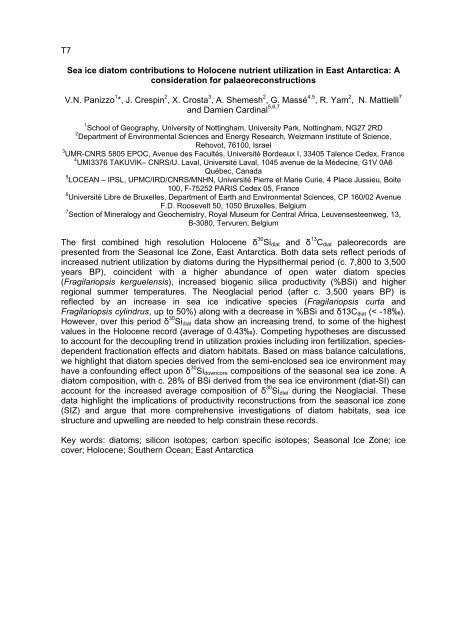The full programme book (PDF) - Royal Geographical Society
The full programme book (PDF) - Royal Geographical Society
The full programme book (PDF) - Royal Geographical Society
Create successful ePaper yourself
Turn your PDF publications into a flip-book with our unique Google optimized e-Paper software.
T7<br />
Sea ice diatom contributions to Holocene nutrient utilization in East Antarctica: A<br />
consideration for palaeoreconstructions<br />
V.N. Panizzo 1 *, J. Crespin 2 , X. Crosta 3 , A. Shemesh 2 , G. Massé 4,5 , R. Yam 2 , N. Mattielli 7<br />
and Damien Cardinal 5,6,7<br />
1 School of Geography, University of Nottingham, University Park, Nottingham, NG27 2RD<br />
2 Department of Environmental Sciences and Energy Research, Weizmann Institute of Science,<br />
Rehovot, 76100, Israel<br />
3 UMR-CNRS 5805 EPOC, Avenue des Facultés, Université Bordeaux I, 33405 Talence Cedex, France<br />
4 UMI3376 TAKUVIK– CNRS/U. Laval, Université Laval, 1045 avenue de la Médecine, G1V 0A6<br />
Québec, Canada<br />
5 LOCEAN – IPSL, UPMC/IRD/CNRS/MNHN, Université Pierre et Marie Curie, 4 Place Jussieu, Boite<br />
100, F-75252 PARIS Cedex 05, France<br />
6 Université Libre de Bruxelles, Department of Earth and Environmental Sciences, CP 160/02 Avenue<br />
F.D. Roosevelt 50, 1050 Bruxelles, Belgium<br />
7 Section of Mineralogy and Geochemistry, <strong>Royal</strong> Museum for Central Africa, Leuvensesteenweg, 13,<br />
B-3080, Tervuren, Belgium<br />
<strong>The</strong> first combined high resolution Holocene δ 30 Si diat and δ 13 C diat paleorecords are<br />
presented from the Seasonal Ice Zone, East Antarctica. Both data sets reflect periods of<br />
increased nutrient utilization by diatoms during the Hypsithermal period (c. 7,800 to 3,500<br />
years BP), coincident with a higher abundance of open water diatom species<br />
(Fragilariopsis kerguelensis), increased biogenic silica productivity (%BSi) and higher<br />
regional summer temperatures. <strong>The</strong> Neoglacial period (after c. 3,500 years BP) is<br />
reflected by an increase in sea ice indicative species (Fragilariopsis curta and<br />
Fragilariopsis cylindrus, up to 50%) along with a decrease in %BSi and δ13C diat (< -18‰).<br />
However, over this period δ 30 Si diat data show an increasing trend, to some of the highest<br />
values in the Holocene record (average of 0.43‰). Competing hypotheses are discussed<br />
to account for the decoupling trend in utilization proxies including iron fertilization, speciesdependent<br />
fractionation effects and diatom habitats. Based on mass balance calculations,<br />
we highlight that diatom species derived from the semi-enclosed sea ice environment may<br />
have a confounding effect upon δ 30 Si downcore compositions of the seasonal sea ice zone. A<br />
diatom composition, with c. 28% of BSi derived from the sea ice environment (diat-SI) can<br />
account for the increased average composition of δ 30 Si diat during the Neoglacial. <strong>The</strong>se<br />
data highlight the implications of productivity reconstructions from the seasonal ice zone<br />
(SIZ) and argue that more comprehensive investigations of diatom habitats, sea ice<br />
structure and upwelling are needed to help constrain these records.<br />
Key words: diatoms; silicon isotopes; carbon specific isotopes; Seasonal Ice Zone; ice<br />
cover; Holocene; Southern Ocean; East Antarctica
















